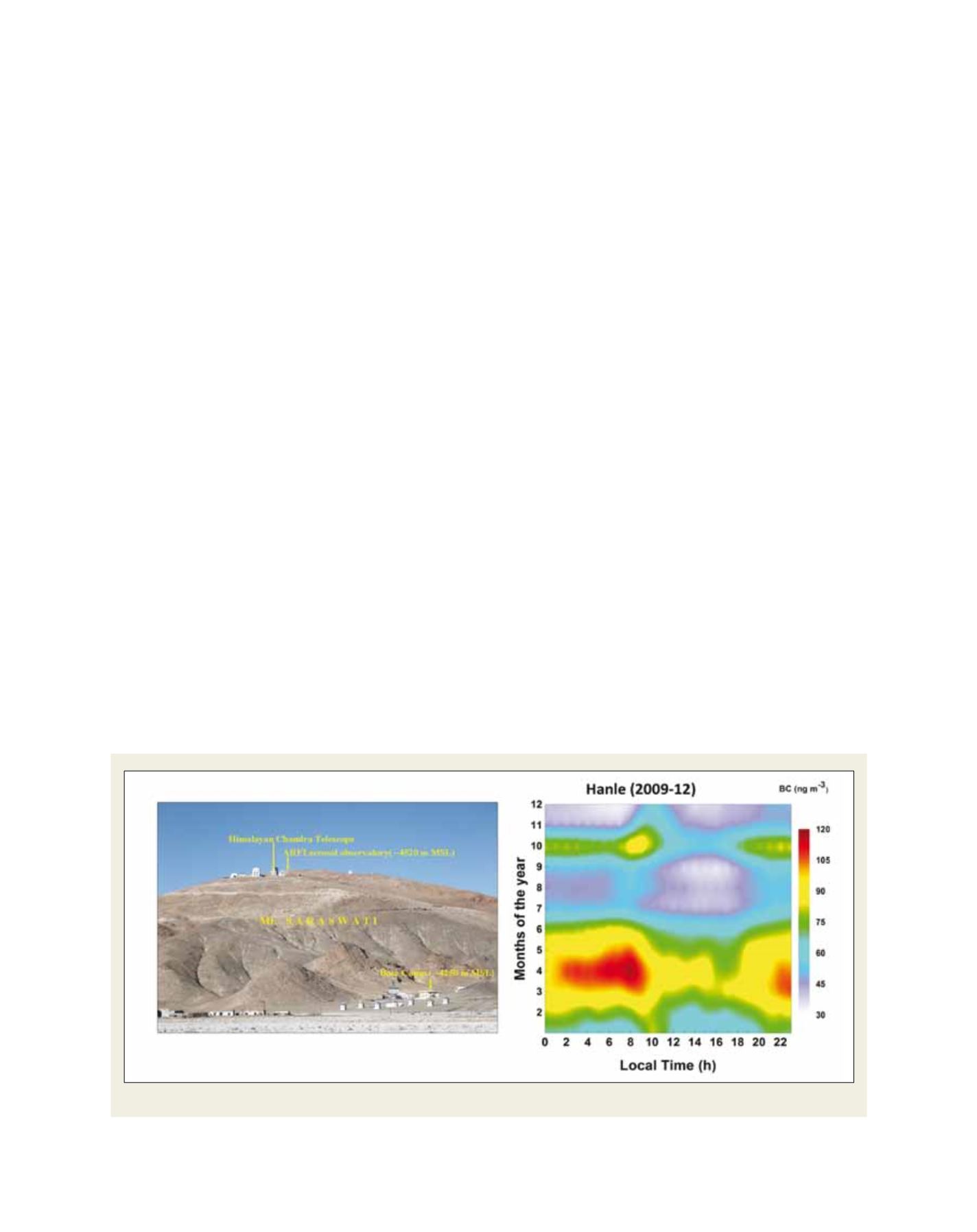

[
] 111
H
ealth
ently high BC concentrations prevailing over the IGP and
the north-eastern regions of India, compared to the south-
ern and western parts. In addition, BC concentrations
show temporal variations on both diurnal and seasonal
scales. While the diurnal variations are pronounced over
the plains, and are mostly associated with atmospheric
boundary layer (ABL) dynamics, the seasonal variations
(winter high and summer low) are influenced by synoptic
monsoon circulation modulated by the seasonal changes
in the convective mixing and the resulting enhanced verti-
cal dispersal of BC in the ABL during summer. Additional
contributions arise from the heterogeneous spatial distri-
bution of the sources. The higher organic carbon (OC) to
BC ratio (typically >5 except in cities) seen over Indian
regions indicates the significant contribution of biomass
burning and also that total carbon over India is more scat-
tering (less absorbing) in nature.
11
Unlike over the landmass, variations over the oceans
are more controlled by transport and driven by meteorol-
ogy. Extensive measurement of BC and its fraction of total
aerosol mass made over the Arabian Sea during the Arabian
Sea Monsoon Experiment (ARMEX) have shown a seven-
fold decrease in BC concentration (~700 ng m
-3
to ~100 ng
m
-3
), associated with changes in synoptic winds between
continental and marine environments.
12
Radiative trans-
fer calculations show that such large decrease in BC leads
to significant decrease in atmospheric forcing (heating)
efficiency (from 70 W m
-2
τ
-1
to 15 W m
-2
τ
-1
). Based on
the most exhaustive shipboard measurements under the
Integrated Campaign for Aerosols, gases and Radiation
Budget (ICARB) and Winter_ICARB (W_ICARB), the
spatial distribution of BC has been shown with associated
atmospheric warming over the oceanic regions around
India and a strong seasonality associated with synoptic
meteorology and forest fires.
13
The concentration of BC
from Trivandrum, a coastal station at the southern tip of the Indian
Peninsula
7
using a dual-channel aethalometer. Synthesizing aerosol
absorption with other optical and physical properties of aerosols, from
collocated and concurrent measurements, a quantification of the effect
of BC on aerosol forcing was done over an urban site for the first time
in India,
8
which showed that large BC absorption led to a change in the
sign of the forcing at the top of the atmosphere. This was perhaps the
first regional effort in this direction.
Taking a cue from this, and realizing the highly heterogene-
ous sources of carbonaceous aerosols over this region arising from
varying living habits, long-term measurements of BC using similar
and inter-compared instruments following well-laid protocols have
been established under ISRO-GBP, in a phased manner, involving a
large number of universities and research institutions. These were
also supported by thematic field campaigns (fixed stations and mobile
platforms) over the mainland, shipboard measurements over oceans,
and aircraft and balloon experiments.
Spatio-temporal changes in BC concentrations over the landmass
arise due to changes in the synoptic and regional meteorology as well
as changes in human activities (agricultural waste burning, forest fires
etc). While these are quite significant, it is difficult to characterize them
because of the large inter-annual variations in these processes. A land
campaign (LC-I) was conducted in February-March 2004, to under-
stand the spatial distribution of aerosol including BC over central and
peninsular India, using identical instruments over spatially separated
locations, covering an area of more than 1 million square kilometres.
9
This was followed up with Land Campaign II (LC-II) in December
2004,
10
during which BC and composite aerosol measurements were
made with atmospheric boundary layer parameters along a chain of
stations in the Indo-Gangectic plain (IGP).
The ARFINET network of BC observatories was established under the
ARFI project of ISRO-GBP. It has data from 32 observatories, including
the two island stations to study long-range transport and spatial gradi-
ents. This forms the only long-term and exhaustive source of primary
data over the region. Spatial distribution measurements show consist-
Source: ARFI
The Himalayan aerosol observatory at Hanle (left); the mean picture of diurnal and monthly temporal evolution of BC over the area (right)
















